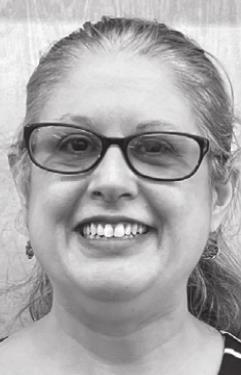
Answers to Go
SAN MARCOS PUBLIC LIBRARY 625 E. HOPKINS ST. 512-393-8200
Q. What is the Community Forestry Program and why is it important?
A. The Community Forestry Program supports the health and well-being of trees in an urban environment. The importance of trees in cities cannot be overstated. Trees contribute to the health and wealth of urban communities like nothing else can.
The Community Forestry Program in San Marcos is relatively new, having been created in November of 2017 when arborist Kelly Eby was hired. Kelly wears a lot of different hats for the city. Not only is she an arborist/urban forester working with trees, but she works with various city departments such as the Utility Office, Engineering and the Planning Office. Right now, she is dealing with the trees from the February 2021 freeze. For example, 40% of the Hills of Hays’ ash trees were damaged and she is asking homeowners to be aware of the risks of trees falling down. For a list of tree risks, visit treesaregood.org
There are many other projects on her radar. One program she is promoting is the “Friends of Trees” stewardship program that encourages members of the public to care for the trees in our neighborhood parks. For this program she asks volunteers to give 2-3 hours of service to “make some little trees happy and strong.” Activities vary by site and may include mulching, planting, pruning, root collar excavation and more. Experience is not necessary and instruction and tools are provided. In June 2021, volunteers helped Purgatory Creek Nature Area on Sept. 17, from 9 a.m. – 12 p.m., volunteers will work on the trees in City Park. To sign up to participate and to see the different dates and parks that will be worked on, visit signupgenius.com/go/409044fa8a92ca6f49friends1 or call Kelly Eby at 512-393-8486.
Another aspect of Eby’s work with trees is the attention she’s given the community parks. Due to construction damage, drought and compacted soil she has been aerating the soil and mulching. In addition to working with existing trees, there are newly planted trees to manage, such as the 100 trees in the new crosstown pathway running from Ramon Lucio to City Park. Kelly’s office is at the Discovery Center where there are fall and spring plant sales. These sales are primarily for native plants, but Kelly has also had several tree giveaways. Between October and February she likes to do a tree giveaway and she’s currently working on getting 1,400 trees to give away to San Marcos residents. For information about any tree giveaways or the Friends of Trees stewardship programs, contact Kelly at Keby@sanmarcostx.gov. San Marcos Utility also has a shade tree rebate program. For information on the rebate program, visit sanmarcostx.gov/3026/ Shade-Tree-Rebate-Program and for more information on other Sustainability Resources, visit sanmarcostx.gov/3276/Sustainability-Resources. One of the many perks is free mulch, double ground, on one of the city’s advertised brushy drop-off days.
Urban forestry is acknowledged as a vital aspect of community planning and growth in many urban areas, not just San Marcos. According to the AmericanForests.org, trees are a “pathway for social equity” and they “can now calculate a Tree Equity Score for urban areas — cities and nearby small towns that have at least 50,000 people — across the United States. The score is an indicator of whether the neighborhood has the right number of trees so all people experience the health, economic and other benefits that trees provide.” To find San Marcos’ Tree Equity Score (which is broken down by various neighborhoods) visit americanforests.org/ourwork/tree-equity-score/.
What are the benefits of more trees? According to Treesaregood.org, there are many. Some are:
Property values of landscaped homes are 5% – 20% higher than non-landscaped homes.
Air conditioning costs are lower in a tree-shaded home, and heating costs are reduced when a home has a windbreak.
Leaves filter the air we breathe by removing dust and other particles; absorbing carbon dioxide and various air pollutants such as ozone, carbon monoxide and sulfur dioxide; and release oxygen.
Deciduous shade trees cool homes in the summer and allow the winter sun to heat homes when they lose their leaves.
Trees help cool the environment, working as a simple and effective way to reduce urban heat islands (pavement and buildings in commercial areas cause higher temperatures by absorbing the sun’s heat).
Trees can serve as a windbreak. The more compact the foliage on the group of trees the more effective the windbreak.
Trees intercept water, store some of it and reduce stormwater runoff.
For more information about urban forestry check out the book “Urban Forests: A Natural History of Trees and People in the American Cityscape” by Jill Jonnes. If you don’t have access to a computer and want to see the items that have internet links in this article, just visit the library to use one of our computers. If you need help, just ask.
Suzanne Sanders is the new columnist for the library. She is the Community Services Manager for the San Marcos Public Library and came from the Austin Public Library in 2015 after having served there as a librarian for over 20 years. She gratefully accepts your questions for this column.











